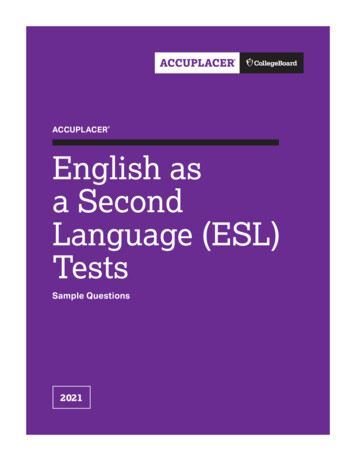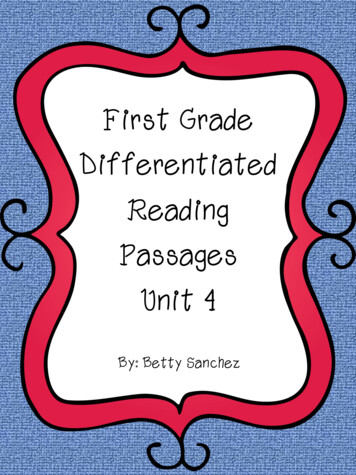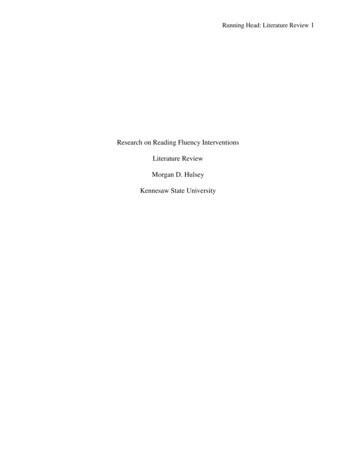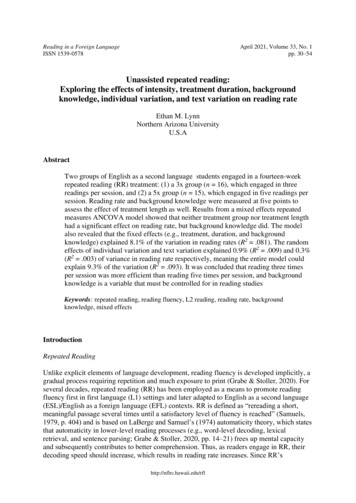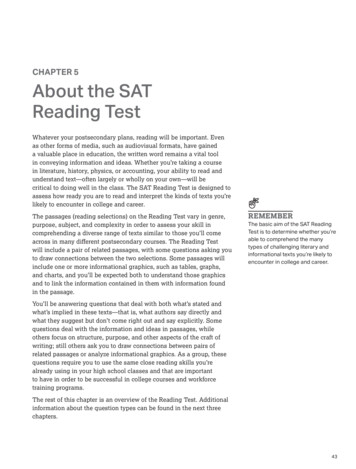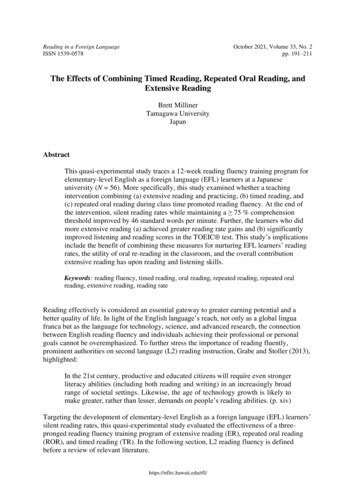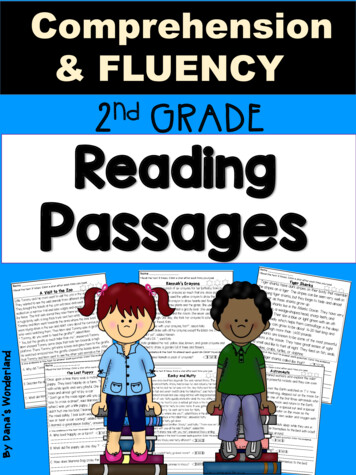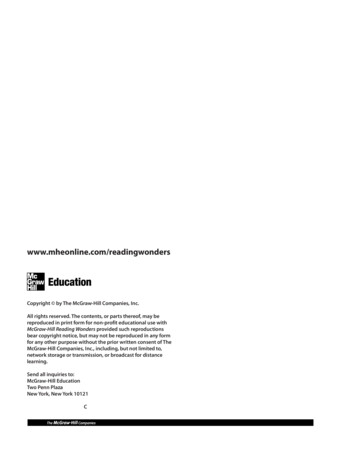
Transcription
www.mheonline.com/readingwondersCopyright by The McGraw-Hill Companies, Inc.All rights reserved. The contents, or parts thereof, may bereproduced in print form for non-profit educational use withMcGraw-Hill Reading Wonders provided such reproductionsbear copyright notice, but may not be reproduced in any formfor any other purpose without the prior written consent of TheMcGraw-Hill Companies, Inc., including, but not limited to,network storage or transmission, or broadcast for distancelearning.Send all inquiries to:McGraw-Hill EducationTwo Penn PlazaNew York, New York 10121C
Table of ContentsTeacher IntroductionvUnit 1Week 1 Assessment1Week 2 Assessment12Week 3 Assessment23Week 4 Assessment34Week 5 Assessment45Unit 2Week 1 Assessment56Week 2 Assessment67Week 3 Assessment78Week 4 Assessment89Week 5 Assessment100Copyright The McGraw-Hill Companies, Inc.Unit 3Week 1 Assessment111Week 2 Assessment122Week 3 Assessment133Week 4 Assessment144Week 5 Assessment155
Table of Contents– Cont’d.Unit 4Week 1 Assessment166Week 2 Assessment177Week 3 Assessment188Week 4 Assessment199Week 5 Assessment210Unit 5Week 1 Assessment221Week 2 Assessment232Week 3 Assessment243Week 4 Assessment254Week 5 Assessment265Unit 6276Week 2 Assessment287Week 3 Assessment298Week 4 Assessment309Week 5 Assessment320Copyright The McGraw-Hill Companies, Inc.Week 1 Assessment
Teacher IntroductionApproaching-Level Weekly AssessmentApproaching-Level Weekly Assessment is a valuable differentiation option in the completeassessment program aligned with McGraw-Hill Reading Wonders and the Common CoreState Standards (CCSS).Purpose of Approaching-Level Weekly AssessmentApproaching-Level Weekly Assessment offers the opportunity to assess Approaching-Levelstudents on their understanding of key skills and strategies and not their ability to readOn-Level texts.The assessment allows you to monitor student progress in a steady and structured manner while providingformative assessment data; to verify or update student grouping and leveling decisions; to inform future instruction; and to use student performance as a guide to entry into On-Level instruction.Focus of Approaching-Level Weekly AssessmentApproaching-Level Weekly Assessment focuses on the same key CCSS areas as WeeklyAssessment—Reading and Language. Students will read two selections each week andrespond to items focusing on Comprehension Skills and Vocabulary Strategies. These itemsassess the ability to access meaning from the text and demonstrate understanding ofunknown and multiple-meaning words and phrases.Copyright The McGraw-Hill Companies, Inc.Administering Approaching-Level Weekly AssessmentEach assessment should be administered once the instruction for the specific week iscompleted. Make copies of the assessment for the Approaching-Level students in your class.You will need one copy of the Answer Key page for each student taking the assessment. Thescoring table at the bottom of the Answer Key provides a place to list student scores. Theaccumulated data from each assessment charts student progress and underscores strengthsand weaknesses.After each student has a copy of the assessment, provide a version of the followingdirections: Say: Write your name and the date on the question pages for this assessment.(When students are finished, continue with the directions.) You will read two selections andanswer questions about them. Read each selection and the questions that follow it carefully. Forthe multiple-choice items, completely fill in the circle next to the correct answer. When you havecompleted the assessment, put your pencil down and turn the pages over. You may begin now.Answer procedural questions during the assessment, but do not provide any assistance onthe items or selections. After the class has completed the assessment, ask students to verifythat their names and the date are written on the necessary pages.Approaching-Level Weekly Assessment Teacher Introductionv
Teacher IntroductionOverview of Approaching-Level Weekly AssessmentEach assessment is comprised of the following 2 “Cold Read” selections 10 multiple-choice items assessing Comprehension Skills 10 multiple-choice items assessing Vocabulary StrategiesReading SelectionsEach assessment features two selections on which the assessment items are based.(In instances where poetry is used, multiple poems may be set as a selection.) The selectionsreflect the unit theme and/or weekly Essential Question to support the focus of theclassroom instruction. Selections increase in complexity as the school year progresses.Comprehension—Multiple–Choice ItemsEach selection is followed by five items, for a total of ten items in a week, that assess studentunderstanding of the text through the use of Comprehension Skills—both that week’sComprehension Skill focus and a review Comprehension Skill. The review skill is taken froma week as near as possible to the current week and aligns with the instruction, i.e., skills thatare more suited to Reading for Information will not be used to assess Reading for Literatureeven though they are in the closest proximity in the program scope and sequence. In Unit 1,Week 1 no review skills are featured, and during the course of the year some weeks featureadditional review questions to best assess student comprehension of the text.Vocabulary—Multiple–Choice ItemsviApproaching-Level Weekly Assessment Teacher IntroductionCopyright The McGraw-Hill Companies, Inc.Each selection is followed by five items, for a total of ten items in a week, that ask students todemonstrate the ability to uncover the meanings of unknown and multiple-meaning wordsand phrases using Vocabulary Strategies—both that week’s Vocabulary Strategy focus anda review Vocabulary Strategy. The review strategy is taken from a week as near as possibleto the current week and aligns with the instruction, i.e., strategies used to identify and gainmeaning from figurative language may not be readily available for use in an informationaltext. In Unit 1, Week 1 no review strategies are featured, and during the course of the yearsome weeks feature additional review questions to best assess student language knowledge.
Teacher IntroductionKey Distinctions Between Approaching-LevelWeekly Assessment and Weekly AssessmentAlthough these components share a similar instructional focus—the skills and strategieson which students are assessed are the same in each—and the selections share thesame subject matter, there are important differences that should determine the properassessment for each student.Differentiated AdministrationApproaching-Level Weekly Assessment is for students who have evidenced the needfor Approaching-Level instruction and support. Weekly Assessment is for students whoare recognized as being On-Level and are progressing through the curriculum withoutobvious difficulty.Reading SelectionsApproaching-Level Weekly Assessment features the selections found in WeeklyAssessment differentiated in the following manner: Word Count—Reduced by 20 to 30 percent Readability and Complexity—Approximately one grade level below the matchingWeekly Assessment selectionAssessment ItemsCopyright The McGraw-Hill Companies, Inc.Approaching-Level Weekly Assessment vocabulary items mirror those featured in WeeklyAssessment except for the selection-specific context being supplied to students.Comprehension items have been differentiated for Approaching-Level Weekly Assessmentin the following manner: Simplified language in item stems Reducing language in the answer choices Using more familiar vocabulary in item stems and answer choicesConstructed ResponseApproaching-Level Weekly Assessment does not include the optional constructedresponse item from Weekly Assessment. However, you may administer it at your discretionif you feel written performance will clarify a student’s current achievement status.Approaching-Level Weekly Assessment Teacher Introductionvii
Teacher IntroductionEvaluating Approaching-Level WeeklyAssessment ScoresMultiple-choice items are worth one point each, for a total of twenty points in eachassessment. The focus of each assessment is to evaluate student progress toward mastery ofpreviously-taught skills and strategies and to determine which students might be ready forentry into On-Level instruction.The expectation is for students to score 80% or higher on the assessment as a whole. Withinthis score, the expectation is for students to score higher than 6/8 on the items assessing theparticular week’s Comprehension Skill and Vocabulary Strategy.For students who do not meet these benchmarks or whose results evidence a lack ofunderstanding, make instructional decisions using intervention options that are available toyou, including assigning appropriate lessons from the Tier 2 online PDFs.The Answer Keys in Approaching-Level Weekly Assessment have been constructed toprovide the information you need to aid your understanding of student performance.This column lists the instructional contentfor the week that is assessed in each item.CorrectQuestion AnswerContent FocusThis column lists the CCSS alignment foreach assessment item.CCSSComplexityThis column lists the Depth of Knowledgeassociated with each item.GMain Idea and Key DetailsRI.3.2DOK 215BMain Idea and Key DetailsRI.3.2DOK 216IContext CluesL.3.4aDOK 217APrefix re-L.3.4bDOK 1Weekly review items are shaded in forclear identification.Comprehension 1, 2, 4, 6, 7, 10, 12, 14, 16, 17/10%Vocabulary 3, 5, 8, 9, 11, 13, 15, 18, 19, 20/10%Total Approaching-Level Weekly Assessment Score/20%Scoring rows identify items associatedwith Reading and Language strands andallow for quick record keeping.viiiApproaching-Level Weekly Assessment Teacher IntroductionCopyright The McGraw-Hill Companies, Inc.14
UNIT 1WEEK 1Read the story “Singing Out” before answeringNumbers 1 through 10.Singing OutNina Martinez shut the classroom door behind her andwalked down the hall. She trudged up the steps to the secondfloor. She felt nervous this morning. She couldn’t believe that shedecided to try out for the talent show. She loved to sing but shedisliked singing in front of other people.Copyright The McGraw-Hill Companies, Inc.Taking a deep breath, she pushed open the door of theauditorium and went inside. The room was filled with laughingchildren. Nina saw Luz and James and others from her class. Thebright, sunny room left her no place to hide. A few teachers sat onfolding chairs. They waited for the children to settle down. Therewas the stage, cold and bare.GO ON Approaching-Level Weekly Assessment Unit 1, Week 1Grade 31
UNIT 1WEEK 1“Hi, Nina!” Luz called out. “I didn’t think you would tryout. You are so timid in front of people.”“That’s nonsense,” Nina said. “I’m not shy at all.”“Yeah, right,” Luz chuckled and ran off to find a seat. Ninafollowed, dragging her feet. She wished she were downstairssitting at her desk. What had she gotten herself into?One by one the students got up on the stage and did their acts.“Nina Martinez!” a voice called out. It was Mrs. Brent, themusic teacher.Nina rose from her chair. She felt small as she walked to theenormous, empty stage. Her face was hot, and her shaking handswere as cold as ice. She fumbled with the sheet music of herfavorite song. She tried to sing, but the words would not come out.“I–I–” Nina began, and then stopped. “I can’t,” she said softly.“Close your eyes. Pretend you are alone,” said Mrs. Brentgently. “Forget about everyone else. Just sing.”Copyright The McGraw-Hill Companies, Inc.Nina felt silly, but she gave it a try. She shut her eyes andraised her voice and sang out. Her hands stopped shaking. Thesong poured out like honey from a jar.Nina heard Mrs. Brent applaud loudly at the end of hersong. “That’s the first time I have really heard your voice,” shesaid. “You are in the show!”Nina let out a big sigh and smiled happily.GO ON 2Grade 3Approaching-Level Weekly Assessment Unit 1, Week 1
Name:Date:Now answer Numbers 1 through 10. Base your answerson “Singing Out.”1Read this sentence from the story.Taking a deep breath, she pushed open the door of theauditorium and went inside.Which word has almost the SAME meaning as theword auditorium as used in the sentence above?a closetb hallwayc playgroundd theater2Which word BEST describes Nina when she first triesto sing?f angryg lonelyh nervousCopyright The McGraw-Hill Companies, Inc.i tired3Read these sentences from the story.“I didn’t think you would try out. You are so timid infront of people.”Which word has almost the SAME meaning as theword timid?a cleverb helpfulc shyd wildGO ON Approaching-Level Weekly Assessment Unit 1, Week 1Grade 33
Name:4Date:Why does Luz laugh as she runs off to her seat?f She thinks Nina looks silly.g She thinks Nina is very funny.h She does not believe Nina can sing well.i She does not believe Nina is telling the truth.5When Mrs. Brent tells Nina to just sing for herself,it shows that Mrs. Brenta wants Nina to do well.b thinks Nina’s voice is too soft.c does not think Nina will be in the show.d does not think Nina will remember the song.6Read the sentence from the story.“Yeah, right,” Luz chuckled and ran off to find a seat.Which word has almost the SAME meaning as theword chuckled as used in the sentence above?f laughedCopyright The McGraw-Hill Companies, Inc.g sighedh whisperedi yelled7How does Nina feel after Mrs. Brent gives her adviceabout singing?a angryb calmc livelyd nervousGO ON 4Grade 3Approaching-Level Weekly Assessment Unit 1, Week 1
Name:8Date:Read this sentence from the story.She felt small as she walked to the enormous,empty stage.Which word has almost the SAME meaning as theword enormous?f cleang brighth hugei long9Read this sentence from the story.Nina heard Mrs. Brent applaud loudly at the end ofher song.Which word has almost the SAME meaning as theword applaud as used in the sentence above?a clapCopyright The McGraw-Hill Companies, Inc.b listenc playd sing10Which word BEST describes Nina at the end ofthe story?f foolishg luckyh proudi terribleGO ON Approaching-Level Weekly Assessment Unit 1, Week 1Grade 35
UNIT 1WEEK 1Read the story “New Kid in School” before answeringNumbers 11 through 20.New Kid in SchoolJayden watched the kids on the school playground. Somewere swinging on the swings or sliding down the slide, whileothers were kicking a dirty old soccer ball. It was his third day athis new school, and he wished someone would ask him to play.No one did.After school, Jayden walked slowly home. In theneighborhood park, shouting and laughing caught his attention.“Kick it! Kick it to me!” someone hollered.Some neighborhood kids were playing. Jayden recognizedseveral of his classmates. He paused to observe them. He washoping they would see him and ask him to join their game, but noone did.Jayden missed his old friends. “Why did we have to move?”he muttered to himself quietly. “I don’t have any friends here.Back home, I had Shawn and Jorge and Nora.”Copyright The McGraw-Hill Companies, Inc.When he reached his house, it appeared empty. Then henoticed a note. It read: “Barry and I are across the street at ourneighbor’s house. Come on over.”In the neighbor’s backyard, Jayden saw his mother and awoman drinking tea and chatting at a patio table. His three-yearold brother Barry was playing with a little girl in a sandbox.“Hi!” his mother called. “How was school today?”“Okay,” Jayden replied, though it hadn’t been.“This is our neighbor, Mrs. Ori, and her little girl Ava.”GO ON 6Grade 3Approaching-Level Weekly Assessment Unit 1, Week 1
UNIT 1WEEK 1Just then Ava reached out and grabbed the toy car atBarry’s feet.“Uh-oh,” Jayden thought.The car was Barry’s favorite toy, and if anybody elsetouched it, he would wail and kick. But that didn’t happen.Instead, Barry watched Ava roll the car through the sand. Then hepicked up a toy truck and did the same.That night, Jayden did some thinking. “Maybe I was wrong.I’ve been waiting for people to make friends with me. Maybe Ishould try to make friends with them,” he said to himself.The next day, Jayden took a soccer ball to school. Heapproached Tyler, one of the soccer players, on the playground.“Hi,” Jayden smiled. “I got this new soccer ball for mybirthday. Do you want to use it instead of that old mushy one?”Copyright The McGraw-Hill Companies, Inc.“Sure!” Tyler answered. “Do you want to be on my side?What position do you play?”Out loud, Jayden said, “I play forward.”To himself, he said,“Whoever thought Icould learn somethingfrom my three-yearold brother!”GO ON Approaching-Level Weekly Assessment Unit 1, Week 1Grade 37
Name:Date:Now answer Numbers 11 through 20. Base your answerson “New Kid in School.”11Which word BEST describes how Jayden feels on theplayground at the beginning of the story?a excitedb happyc lonelyd tired12Read these sentences from the story.“Kick it! Kick it to me!” someone hollered.Which word has almost the SAME meaning as theword hollered?f answeredg gaspedh shoutedi whisperedCopyright The McGraw-Hill Companies, Inc.13Read these sentences from the story.Jayden recognized several of his classmates. Hepaused to observe them.Which word has almost the SAME meaning as theword recognized as used in the sentence above?a heardb joinedc sawd toldGO ON 8Grade 3Approaching-Level Weekly Assessment Unit 1, Week 1
Name:14Date:Which sentence from the story tells you how Jaydenfeels about the move?f “I don’t have any friends here.”g “Kick it to me!” someone hollered.h Some were swinging on the swings or sliding downthe slide.i In the neighborhood park, shouting and laughingcaught his attention.15Read this sentence from the story.“Why did we have to move?” he muttered tohimself quietly.Which word has almost the SAME meaning as theword muttered?a criedb exclaimedc repeatedCopyright The McGraw-Hill Companies, Inc.d whispered16Read this sentence from the story.In the neighbor’s backyard, Jayden saw his mother anda woman drinking tea and chatting at a patio table.Which word has almost the SAME meaning as theword chatting as used in the sentence above?f chucklingh singingg screamingi talkingGO ON Approaching-Level Weekly Assessment Unit 1, Week 1Grade 39
Name:17Date:Read this sentence from the story.The car was Barry’s favorite toy, and if anybodyelse touched it, he would wail and kick.Which word has almost the SAME meaning as theword wail?a cryb laughc sighd sing18What does Jayden realize when his brother makes anew friend at their neighbor’s house?f His mother was wrong.g No one at school likes him.h He needs to try harder to make friends.i He should make friends with his brother.19Copyright The McGraw-Hill Companies, Inc.Which sentence BEST explains how Jayden feels whenhe walks home from school?a He is sad because school is over.b He is angry because he has to walk.c He is worried because he may get lost.d He is upset because he has no friends.20How does Jayden feel at the end of the story?f happyh shyg pushyi upsetSTOP10Grade 3Approaching-Level Weekly Assessment Unit 1, Week 1
Copyright The McGraw-Hill Companies, Inc.Answer KeyName:QuestionCorrectAnswerContent FocusCCSSComplexity1DSynonymsL.3.4aDOK 22HCharacter, Setting, Plot: CharacterRL.3.3DOK 23CSynonymsL.3.4aDOK 24ICharacter, Setting, Plot: CharacterRL.3.3DOK 35ACharacter, Setting, Plot: CharacterRL.3.3DOK 36FSynonymsL.3.4aDOK 27BCharacter, Setting, Plot: CharacterRL.3.3DOK 28HSynonymsL.3.4aDOK 29ASynonymsL.3.4aDOK 210HCharacter, Setting, Plot: CharacterRL.3.3DOK 211CCharacter, Setting, Plot: CharacterRL.3.3DOK 212HSynonymsL.3.4aDOK 213CSynonymsL.3.4aDOK 214ICharacter, Setting, Plot: CharacterRL.3.3DOK 315DSynonymsL.3.4aDOK 216ISynonymsL.3.4aDOK 217ASynonymsL.3.4aDOK 218HCharacter, Setting, Plot: CharacterRL.3.3DOK 319DCharacter, Setting, Plot: CharacterRL.3.3DOK 320FCharacter, Setting, Plot: CharacterRL.3.3DOK 2Comprehension 2, 4, 5, 7, 10, 11, 14, 18, 19, 20/10%Vocabulary 1, 3, 6, 8, 9, 12, 13, 15, 16, 17/10%Total Approaching-Level Weekly Assessment Score/20%Approaching-Level Weekly Assessment Unit 1, Week 1Grade 311
UNIT 1WEEK 2Read the story “A Lesson Learned” before answeringNumbers 1 through 10.A Lesson LearnedThere once lived a wealthy man named Katu. He onlywanted the finest things in life. He thought everything he ownedwas the best. And he made sure his neighbors knew it.Katu’s elegant home was not good enough for him. Hedecided to build a new house with tall logs. He bragged that hislogs were the best money could buy.Copyright The McGraw-Hill Companies, Inc.Katu needed a sturdy elephant to move the heavy logs. Hefound an elephant named Lago. He was the strongest elephantanyone had ever seen. All the people in the village watched Lagopile the heavy logs to build the house. They were amazed. Katuwatched Lago too. Katu began bragging about his house to twomen who were standing nearby.“You see, my friends,” said Katu, “how wonderful my housewill be. There will be no other house like it. My house will be thebest house in the village.”GO ON 12Grade 3Approaching-Level Weekly Assessment Unit 1, Week 2
UNIT 1WEEK 2Katu continued to admire Lago’s strength. And he continuedto brag. But Katu did not know everything about Lago. Theelephant understood every word that Katu said. The elephant didnot like what he heard. He decided that he had heard enough.One of the men interrupted Katu while he was bragging.The man pointed over Katu’s shoulder.“What is it?” Katu asked in an annoyed voice.Katu tried to ignore the man. The man kept pointing. Katufinally turned around and stopped talking. Lago was comingstraight at him! The two men scrambled out of the way, but Katuwas too afraid to move.Lago seized Katu with his trunk. He lifted Katu high in theair. The elephant held Katu over the new house. Then Lagobumped into it hard. The house swayed and collapsed into a heapof logs. Lago set Katu gently on the ground.Copyright The McGraw-Hill Companies, Inc.It took Katu many weeks to rebuild his house, but he learnedhis lesson. From that day on, he promised never to brag again.GO ON Approaching-Level Weekly Assessment Unit 1, Week 2Grade 313
Name:Date:Now answer Numbers 1 through 10. Base your answerson “A Lesson Learned.”1What happens BEFORE Katu brags that his logs are thebest money could buy?a He watches Lago pile the logs.b He decides to build a new house.c He brags about his house to two men.d He hires a man who owns an elephant.2Which event happens LAST in the story?f Lago siezes Katu with his trunk.g Katu promises to never brag again.h The house collapses into a heap of logs.i The two men scramble out of Lago’s way.3Read this sentence from the story.Katu needed a sturdy elephant to move theheavy logs.Copyright The McGraw-Hill Companies, Inc.What does sturdy mean in the sentence above?a friendlyb smartc strongd youngGO ON 14Grade 3Approaching-Level Weekly Assessment Unit 1, Week 2
Name:4Date:What happens AFTER Katu brags to the two men butBEFORE Lago runs into Katu’s house?fLago holds Katu over the house.g Katu promises to never brag again.h Katu’s house collapses into a heap of logs.i Lago piles the heavy logs on top of each other tobuild the house.5Read these sentences from the story.All the people in the village watched Lago pile theheavy logs to build the house. They were amazed.What does amazed mean in the sentences above?a restedb satisfiedc shockedd tiredCopyright The McGraw-Hill Companies, Inc.6Read these sentences from the story.There once lived a wealthy man named Katu. He onlywanted the finest things in life.Which word has almost the SAME meaning as the wordwealthy as used in the sentence above?f giftedg famoush helpfuli richGO ON Approaching-Level Weekly Assessment Unit 1, Week 2Grade 315
Name:7Date:What happens AFTER Lago backs away from the fallenhouse?a He runs into the house.b He sets Katu on the ground.c Katu brags about his new house.d Katu hires him to build the house.8Read this sentence from the story.The house swayed and collapsed into a heap of logs.What does collapsed mean in the sentence above?f fellg leanedh shooki stood9What word BEST describes Katu at the end of the story?a braveCopyright The McGraw-Hill Companies, Inc.b richc strongd wise10Read this sentence from the story.The two men scrambled out of the way, but Katu wastoo afraid to move.What does scrambled mean in the sentence above?f crawledh skippedg hurriedi walkedGO ON 16Grade 3Approaching-Level Weekly Assessment Unit 1, Week 2
UNIT 1WEEK 2Read the story “The Ship of the Desert” before answeringNumbers 11 through 20.The Ship of the DesertLong ago, a man was traveling near the desert. He carriedfood and water on his back. He lugged his heavy tent on theground behind him.Suddenly, he saw a strange creature ahead of him. It waslarge, brown, and hairy. The creature bellowed at him. The loudnoise frightened him! The man sped away as fast as he could.Copyright The McGraw-Hill Companies, Inc.The next day, he came across a similar creature. It wasdrinking at the far end of a pool of water. The man was curious.He inched closer to get a better look. The creature had long,skinny legs. It had a long, thick neck. It also had a huge hump onits back!The third day, the man saw more of these odd creatures. Hedecided to observe them carefully to see what he could learn.Sometimes one would stare straight at him. Sometimes onewould bellow. But the man realized that the stares and bellows bythe creatures were not mean. The creatures were actually meekand gentle.The man watched some creatures coming over a high sanddune. He knew the desert extended for miles and miles past thatdune. The man thought, “These creatures can walk in the desertwithout water for a long time!”GO ON Approaching-Level Weekly Assessment Unit 1, Week 2Grade 317
UNIT 1WEEK 2On the fourth day, the man saw one of the gentle giants. Itwas down in the sand with its eyes closed, dozing. The man hadan idea.“Perhaps this creature could help me carry my load,” hethought. So he walked quietly up to the animal. He loaded hisbelongings onto the creature’s back. Then he slipped ontoits hump.The animal awoke and got to its feet. The man rode it all theway home. His children greeted him excitedly. They too wanted toride the wonderful creature.“Now we can make the desert our home!” the man saidhappily. And that is how the camel came to be humans’ greathelper. And that is why we call it “The Ship of the Desert.”Copyright The McGraw-Hill Companies, Inc.GO ON 18Grade 3Approaching-Level Weekly Assessment Unit 1, Week 2
Name:Date:Now answer Numbers 11 through 20. Base your answerson “The Ship of the Desert.”11Read this sentence from the story.He lugged his heavy tent on the ground behind him.What does the word lugged mean in thesentence above?a bouncedb kickedc pulledd smashed12Read this sentence from the story.The man sped away as fast as he could.Which word has almost the SAME meaning as the wordsped as used in the sentence above?f crawledCopyright The McGraw-Hill Companies, Inc.g dancedh inchedi rushed13What happens right AFTER the man sees the creaturedrinking from the pool of water.a He returns home to his family.b He runs away as fast as he can.c He lugs his belongings behind him.d He inches closer to get a better look.GO ON Approaching-Level Weekly Assessment Unit 1, Week 2Grade 319
Name:14Date:Read this sentence from the story.He decided to observe them carefully to see what hecould learn.What does observe mean in the sentence above?f keep safeg take care ofh do things fori look at closely15Read this sentence from the story.He knew the desert extended for miles and miles pastthat dune.What does extended mean in the sentence above?a dividedb endedc finished16Copyright The McGraw-Hill Companies, Inc.d stretchedWhat happens BEFORE the man speeds away as fastas he can?f The creature bellows at him.g The creature stares straight at him.h He rides the creature all the way home.i He moves closer to get a better look at the creature.GO ON 20Grade 3Approaching-Level Weekly Assessment Unit 1, Week 2
Name:17Date:Read this sentence from the story.It was down in the sand with its eyes closed, dozing.What does dozing mean in the sentence above?a diggingb drinkingc eatingd sleeping18What happens on the THIRD day?f The man sees a creature sleeping in the sand.g The man realizes the creatures are meek and gentle.h The man uses a creature to help him carry his heavy load.i The man sees a creature getting a drink from a poolof water.19What happens on the FOURTH day?Copyright The McGraw-Hill Companies, Inc.a The man sees a strange creature ahead of him.b The man carries his heavy tent through the desert.c The man sees more and more of these odd creatures.d The man loads all of his belongings on the creature’s back.20What word best describes the man when he FIRST seesthe creature?f boredg friendlyh frightenedi interestedSTOPApproaching-Level Weekly Assessment Unit 1, Week 2Grade 321
Answer KeyName:CorrectAnswerContent FocusCCSSComplexity1BCharacter, Setting, Plot: SequenceRL.3.7DOK 12GCharacter, Setting, Plot: SequenceRL.3.7DOK 13CContext Clues: Sentence CluesL.3.4aDOK 24FCharacter, Setting, Plot: SequenceRL.3.7DOK 15CContext Clues: Sentence CluesL.3.4aDOK 26ISynonymsL.3.4aDOK 27BCharacter, Setting, Plot: SequenceRL.3.7DOK 18FContext Clues: Sentence CluesL.3.4aDOK 29DCharacter, Setting, Plot: CharacterL.3.4aDOK 210GContext Clues: Sentence CluesRL.3.7DOK 211CContext Clues: Sentence CluesL.3.4aDOK 212ISynonymsL.3.4aDOK 213CCharacter, Setting, Plot: SequenceRL.3.2DOK 114IContext Clues: Sentence CluesL.3.4aDOK 215DContext Clues: Sentence CluesL.3.4aDOK 216FCharacter, Setting, Plot: SequenceRL.3.7DOK 117DContext Clues: Sentence CluesL.3.4aDOK 218GCharacter, Setting, Plot: SequenceRL.3.7DOK 119DCharacter, Setting, Plot: SequenceRL.3.7DOK 120HCharacter, Setting, Plot: CharacterRL.3.7
Mar 13, 2016 · text. In Unit 1, Week 1 no review strategies are featured, and during the course of the year some weeks feature additional review questions to best assess student language knowledge. Program: Core Reading Vendor: Aptara Component: AWA_FM Grade: 3 PDF Proof vi A

